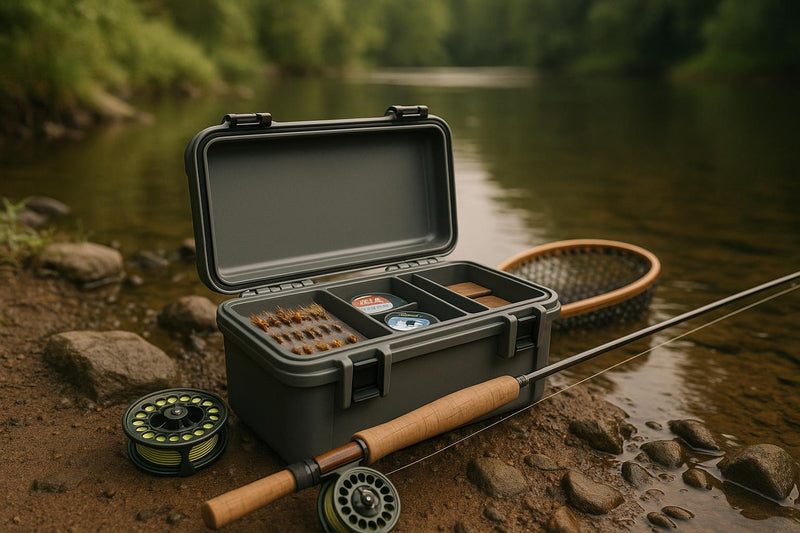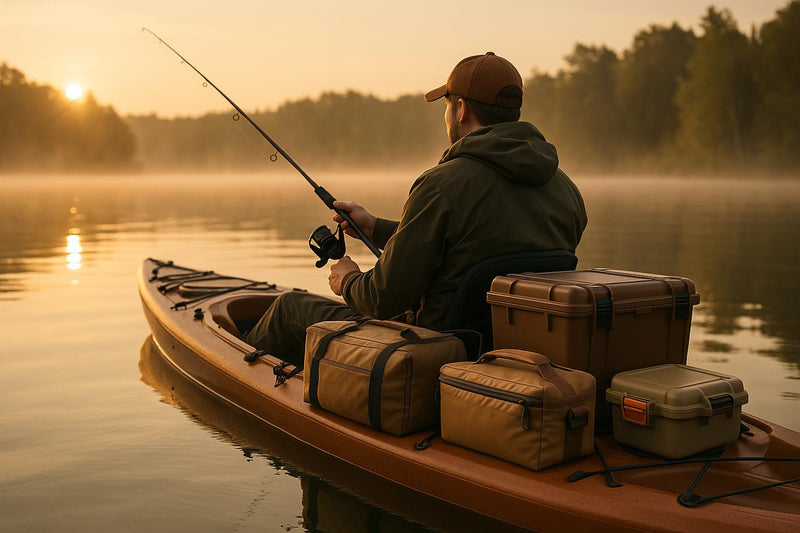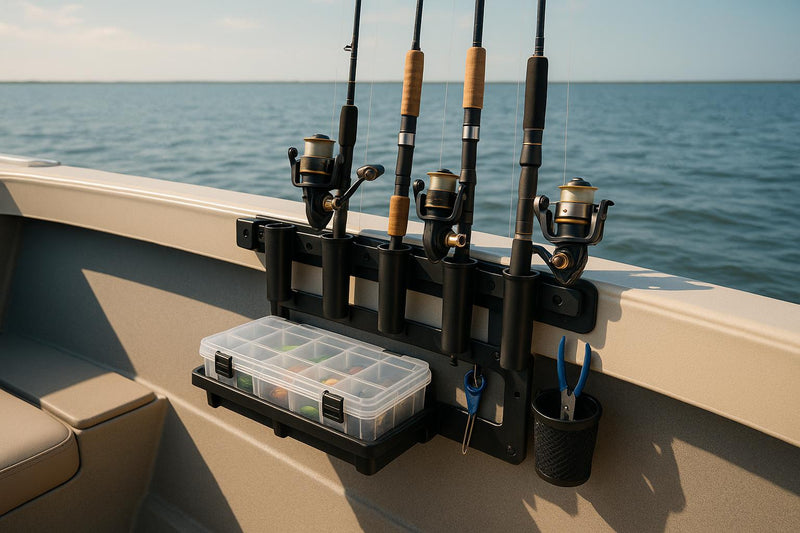Fishing shorts made with quick-dry fabrics are essential for staying dry and comfortable during long fishing trips. These materials wick moisture away from your skin and dry faster than traditional fabrics like cotton. Here’s a breakdown of the top fabrics used in fishing shorts:
- Nylon: Known for its drying speed, moisture-wicking, and durability. It’s lightweight and resists abrasions but can weaken under prolonged UV exposure.
- Polyester: Dries even faster than nylon, resists UV rays, and handles saltwater better. However, it’s less stretchy and can feel rougher.
- Spandex/Elastane Blends: Adds stretch for greater mobility, making movements easier. These blends retain quick-dry properties but may degrade faster with exposure to saltwater or UV rays.
- Ripstop Fabric: Extremely durable due to its tear-resistant grid design. It’s ideal for rugged conditions but lacks natural stretch unless blended with elastic materials.
Each fabric offers unique benefits depending on your needs, from quick drying to flexibility and durability.
Quick Comparison:
| Fabric Type | Drying Speed | Moisture-Wicking | Durability | Stretch/Mobility | Key Weakness |
|---|---|---|---|---|---|
| Nylon | Moderate | Good | Moderate | High | UV sensitivity, absorbs water |
| Polyester | Fast | Excellent | High | Limited | Rough texture, less flexible |
| Spandex Blends | Fast | Good | Moderate | Outstanding | Degrades with saltwater/UV |
| Ripstop Fabric | Fast | Excellent | Outstanding | Limited | Limited stretch |
Choose the fabric that best suits your fishing conditions. For all-around performance, hybrid designs combining these materials can offer the best mix of comfort, durability, and drying efficiency.
HUK Next Level Shorts

1. Nylon
Nylon is a go-to material for quick-dry fishing shorts, and it’s easy to see why outdoor gear manufacturers favor this synthetic fabric. Katina Lin from OEM Apparel Manufacturer explains its appeal:
"Nylon is the best for fishing shirts. It's a high performance material. It will give your customers value and reliability."
This synthetic polymer, made from polyamides, is a staple in fishing apparel, offering practical benefits that make long days on the water more comfortable. Let’s dive into how nylon’s drying speed, moisture management, durability, and stretch properties make it a top choice for anglers.
Drying Speed
Nylon shines when it comes to drying quickly, outpacing traditional fabrics like cotton. Thanks to its low water absorption rate, nylon moves from wet to damp in about 30 minutes and fully dries in around two hours under typical conditions. This quick-dry feature is a game-changer for anglers who spend hours in wet environments.
Moisture-Wicking Efficiency
Nylon’s hydrophobic nature and capillary action work together to wick moisture away from the skin, keeping you dry even in humid settings. With a moisture regain value of just 4%, it efficiently pulls sweat to the fabric's surface, where it can evaporate.
Many modern nylon fabrics are engineered with special additives or innovative weaves to improve breathability, ensuring all-day comfort on the water.
Durability
Durability is another area where nylon excels. It resists abrasions and snags, making it ideal for rugged fishing conditions. However, prolonged exposure to intense UV rays can weaken the fabric over time. To address this, some variations like nylon 6 or nylon 12 offer better UV resistance compared to nylon 6/6. For extended fishing trips, look for nylon shorts with a UPF 50+ rating, which blocks at least 98% of harmful UV rays. Manufacturers often enhance nylon with UV blockers or stabilizers to increase its longevity and protect against fading.
Stretch and Mobility
While nylon is tough and moisture-resistant, it can sometimes feel a bit rigid. That’s why many fishing shorts incorporate elastane or spandex blends to improve stretch and mobility. These blends provide greater flexibility for active movements without sacrificing nylon’s durability and moisture-wicking benefits. Additionally, nylon’s structured nature helps it retain its shape over time, making it a practical choice for fishing gear that demands both resilience and moderate flexibility.
Nylon’s combination of quick-drying, moisture management, durability, and adaptability makes it a standout material for fishing shorts, ensuring comfort and reliability for anglers on the go.
2. Polyester
When it comes to quick-dry fishing gear, polyester stands out as a top contender. While nylon delivers solid performance, polyester brings additional perks that make it a favorite among anglers, especially for fishing shorts. As Dagon Fishing highlights, "Polyester is the most widely used fabric type in fishing shirts, offering many advantages over other fabric types". Its unique properties make it a reliable choice for anyone spending long hours on the water.
Drying Speed
Polyester is unmatched in drying speed. In fact, polyester garments can dry completely in under two hours. In one test, a 100% polyester t-shirt dried in just 34 minutes, whereas a 100% Merino wool t-shirt took 48 minutes. This quick-drying ability comes from polyester's hydrophobic nature - it repels water rather than soaking it up. To put it in perspective, polyester absorbs only 0.4% of its weight in moisture, while cotton can absorb up to 10 times its weight. For anglers wearing high-performance fishing shorts, this means staying comfortable and dry even after exposure to water. This fast drying also plays a major role in managing moisture effectively.
Moisture-Wicking Efficiency
Another standout feature of polyester is its excellent moisture-wicking ability. The fabric pulls sweat away from the skin and transfers it to the outer surface, where it evaporates quickly. This helps avoid the sticky, damp feeling that cotton often causes, as cotton can absorb up to 7% of its weight in sweat. For fishing trips during hot, humid summers, this moisture-wicking capability is a game-changer. Investing in high-quality mens fishing shorts made with polyester ensures both comfort and durability in challenging conditions.
Durability
Polyester's synthetic makeup gives it a durability edge over natural fibers. It's built to last, resisting abrasions and tears better than cotton. This makes it a reliable choice for fishing shorts that see frequent wear and tough conditions. On top of that, more than 70% of polyester fabrics offer UPF 30+ protection, shielding anglers from harmful UV rays. Sandy Flint, Senior Materials Manager at Stio, explains, "Polyester does an excellent job at disrupting UV light". Interestingly, some studies suggest polyester may even provide slightly better UV protection when wet, though this can diminish as the fabric ages. Replacing well-worn gear regularly ensures you continue to benefit from this sun protection.
Stretch and Mobility
While polyester excels in many areas, pure polyester lacks flexibility. To address this, manufacturers often blend it with elastane or spandex, adding stretch for improved mobility. These blends retain polyester's strengths while offering the flexibility needed for active fishing movements. Additionally, polyester resists wrinkles, so your fishing shorts will still look good after being packed in a tackle bag or stored on a boat. This wrinkle resistance, combined with easy care and maintenance, makes polyester an excellent option for multi-day fishing trips. Its ability to hold its shape over time ensures your investment in quality gear pays off with lasting comfort and performance.
3. Spandex/Elastane Blends
Pure nylon and polyester are excellent for their quick-dry properties, but when spandex or elastane is added, it takes fishing shorts to another level. These blends keep the moisture-wicking advantages of their base materials while adding much-needed flexibility. The result? Shorts that move effortlessly with you during those long days on the water.
Stretch and Mobility
One of the standout qualities of spandex/elastane blends is their impressive stretch. Spandex can stretch up to 5–8 times its original length, making it ideal for active anglers. This stretchability creates what manufacturers call "4-way stretch", allowing the fabric to move in every direction. Whether you're casting, reeling in a catch, or navigating your boat, these shorts adapt to your movements seamlessly.
Take, for example, the AFTCO Everyday Stretch Shorts (92% polyester, 8% spandex) or the AFTCO Stretch Original Fishing Shorts with AFLEX 4-way stretch. Another great option is Drake Waterfowl's Performance Hybrid Short (97% nylon taslon, 3% spandex). These designs demonstrate how even a small amount of spandex can improve mobility without compromising the quick-dry functionality. Some fishing shorts even feature hidden elastic waistbands that stretch and adjust as your body moves throughout the day.
Drying Speed
The quick-drying ability of these blends remains intact because the base fabric - whether nylon or polyester - determines the drying speed. For example, nylon-spandex blends dry faster than polyester-spandex ones. A spandex content of 3–8% is common, offering a balance between stretch and drying performance. The higher the spandex percentage, the more flexible the fabric becomes. However, manufacturers carefully manage this ratio to ensure flexibility doesn’t come at the cost of drying efficiency. This balance ensures anglers get the best of both worlds: comfort and mobility without losing the fast-drying feature essential for fishing shorts.
Durability
While spandex offers great stretch, it does have some vulnerabilities. It can degrade over time when exposed to chlorine, heat, body oils, saltwater, and UV rays. Saltwater, in particular, speeds up this process, causing the fabric to lose its elasticity. UV rays can also weaken spandex fibers, leading to sagging and fraying. On its own, elastane provides a UPF rating of 25–39, offering some sun protection, though this can diminish as the fabric ages.
High-quality spandex blends are designed to resist these challenges better. They maintain their shape, stand up to temperature changes, and last longer - but this durability often comes at a higher price. That’s why premium fishing shorts tend to cost more; the quality of the spandex directly impacts their long-term performance. To extend the life of your shorts, it’s a good idea to rinse them in cool water after exposure to saltwater.
For fishing shorts that combine flexibility, quick-drying capabilities, and long-lasting performance, check out Reel Comfort's Mens Fishing Shorts. Up next, we’ll dive into how ripstop fabric enhances durability for even greater performance.
sbb-itb-cb0a783
4. Ripstop Fabric
When it comes to fishing shorts, ripstop fabric is a game-changer for durability. Known for its unique grid-pattern construction, this material prevents small tears from spreading, making it a reliable choice for rugged outdoor activities. As Donovan Mathews from Bryden Apparel puts it:
"Ripstop fabric stands out among other fabrics because of its strength and durability...the fabric is rip-resistant."
Beyond its toughness, ripstop fabric shares the fast-drying qualities of nylon and polyester, ensuring comfort during long days on the water.
Durability
Ripstop's durability stems from its reinforced grid design. This structure, created with thicker, interwoven threads, stops minor rips from turning into major damage. The fabric is built to handle the wear and tear of fishing, whether it's friction from boat edges, tackle boxes, or other rough surfaces. Ripstop fabric comes in different variations: nylon ripstop is prized for its strength and elasticity, while polyester versions offer excellent UV resistance and maintain their color over time.
Moisture-Wicking Features
Ripstop fabric, especially nylon-based options, is naturally quick-drying and breathable. Its ability to wick moisture efficiently helps regulate body temperature during active fishing trips. This quick-dry capability is a standout feature, ensuring you stay comfortable even in wet conditions. For gear that performs under these demands, check out our collection of Fishing shorts designed with advanced moisture management.
Stretch and Mobility
While ripstop fabric on its own doesn't have much stretch, manufacturers often blend it with spandex to add flexibility without compromising its tear resistance. This innovation is crucial for anglers who need freedom of movement for casting or navigating tough terrains. Reel Comfort incorporates ripstop fabric with four-way stretch panels in their Fishing shorts, offering a combination of durability and mobility. Pair this with the fabric's quick-dry properties, and you have shorts that deliver both strength and comfort. Explore our range of Mens Fishing Shorts to gear up for your next adventure in style and confidence.
Fabric Comparison: Strengths and Weaknesses
Following the detailed breakdown of fabrics earlier, this section focuses on the strengths and weaknesses of each material. Knowing how these fabrics perform under different conditions can help you pick the best option for your fishing trips.
Nylon stands out for its comfort and flexibility, making it a great choice for long hours on the water. Its elasticity allows for free movement, but it does have some downsides. Nylon absorbs more water compared to other synthetic fabrics, which slows drying time, and prolonged sun exposure can weaken it due to UV sensitivity.
Polyester is known for its durability and quick-drying capabilities. It resists UV rays effectively, keeping its color and structure intact even after extended sun exposure. Additionally, it handles saltwater and chlorine better than nylon. However, polyester has a slightly rougher feel and offers less stretch, which might make it less comfortable for some.
Spandex and elastane blends are all about stretch. These fabrics can extend up to five times their original length and snap back into shape, making them ideal for active fishing. When combined with nylon or polyester, they improve fit and comfort without sacrificing moisture-wicking properties.
Ripstop fabric is built for durability, thanks to its reinforced grid pattern that prevents small tears from spreading. While it excels in tear resistance and longevity, it lacks natural stretch unless blended with elastic materials.
| Fabric Type | Drying Speed | Moisture-Wicking | Durability | Stretch/Mobility | Key Weakness |
|---|---|---|---|---|---|
| Nylon | Moderate | Good | Moderate | Excellent | Absorbs water, UV sensitivity |
| Polyester | Fast | Excellent | High | Limited | Rougher texture, less flexible |
| Spandex/Elastane Blends | Fast | Good | Moderate | Outstanding | Needs blending with other fabrics |
| Ripstop Fabric | Fast | Excellent | Outstanding | Limited | Limited stretch |
For the best fishing shorts, combining multiple fabric technologies is often the way to go. Reel Comfort shorts, for instance, pair ripstop fabric for durability with four-way stretch panels for improved mobility. If quick-dry performance is your top priority, polyester-based fabrics are a strong choice. Meanwhile, anglers looking for maximum comfort and flexibility will appreciate nylon or spandex blends. And for those who need extra protection against wear and tear, ripstop construction is hard to beat. By weighing these trade-offs, you can find the perfect Mens Fishing Shorts to suit your fishing style and conditions.
Conclusion
Choosing the right quick-dry fabric comes down to matching your gear to your specific fishing environment and needs. Polyester stands out for its fast-drying ability, making it a favorite for anglers looking to stay dry quickly. On the other hand, nylon and spandex blends provide excellent stretch and mobility, though they may take a bit longer to dry.
For those who prioritize durability, ripstop fabric is a smart choice. Its reinforced grid pattern is designed to stop small tears from spreading, ensuring your gear lasts longer and performs better in tough conditions.
If you're looking for a combination of performance features, a hybrid approach is often the best option. Take a look at our Men’s Fishing Shorts, which pair ripstop fabric for durability with four-way stretch panels for added mobility. This thoughtful blend delivers both protection and comfort.
"Reel Comfort Fishing Shorts are the only shorts you'll ever want to wear on the water. Engineered with slip-in protective pads, they offer unmatched support whether you're reeling in a big catch or standing on deck for hours. No more sore thighs or awkward shifting - just total comfort and focus."
This glowing endorsement highlights the importance of balancing durability and mobility for peak performance. When deciding on the ideal fabric, think about your fishing environment. Saltwater anglers will appreciate polyester’s quick-drying properties, while freshwater fishermen might value the flexibility of nylon blends. For challenging terrains, ripstop fabric’s toughness is a must.
Discover the perfect mix of quick-drying efficiency, durability, and comfort with Reel Comfort’s Fishing Shorts collection.
FAQs
What’s the difference between nylon and polyester in quick-dry fishing shorts?
Nylon stands out for its durability and strength, which makes it tough and resistant to wear. However, it does have a downside - it absorbs more water, which means it takes longer to dry.
Polyester, by contrast, is naturally water-repellent. This quality allows it to dry faster, making it a lightweight option that resists shrinking and stretching. These features make polyester an excellent pick for quick-dry fishing shorts.
While both materials have their perks, polyester often takes the lead for fishing trips thanks to its fast-drying ability and moisture-wicking performance.
How do spandex or elastane blends improve fishing shorts?
Spandex or elastane blends bring a whole new level of comfort and flexibility to fishing shorts. With their ability to stretch and move effortlessly, these materials are perfect for activities like casting and reeling, where unrestricted movement is key. They adapt to your body’s movements, making them a great choice for those long hours spent on the water.
Another advantage? These blends help the shorts hold their shape over time, even with frequent use. This means your fishing shorts stay comfortable and functional, trip after trip, even in tough conditions.
Why is ripstop fabric a great choice for fishing shorts in tough conditions?
Ripstop fabric stands out as a smart option for fishing shorts, especially in tough outdoor conditions, thanks to its tear-resistant weave. This fabric is crafted with reinforced threads that stop small tears from growing, giving it the durability needed for intense outdoor adventures.
On top of that, ripstop fabric is lightweight and dries quickly, making it perfect for fishing trips where comfort and functionality matter. Whether you're trekking over rocky terrain or dealing with heavy fishing gear, this material delivers dependable protection and toughness.




